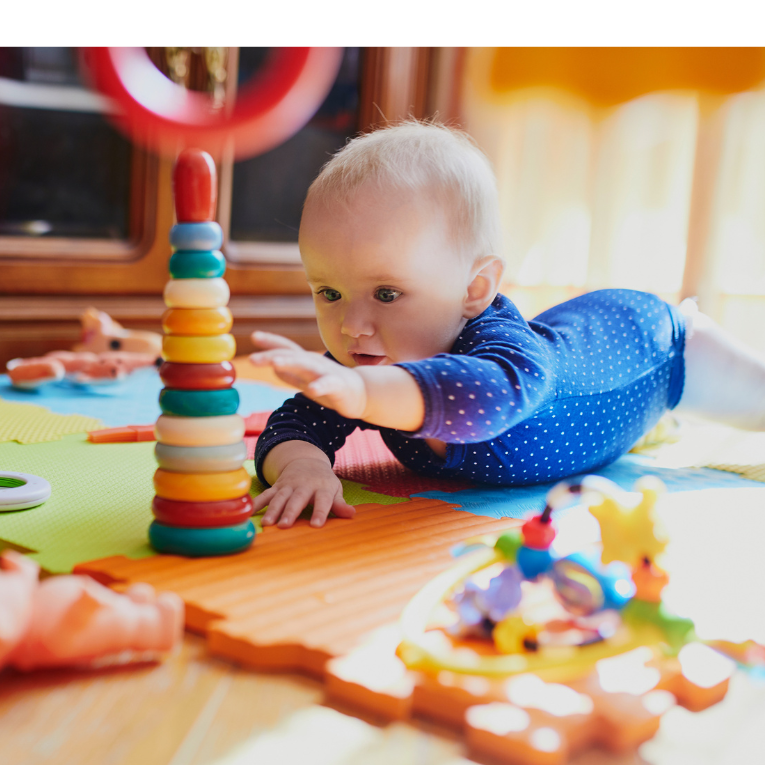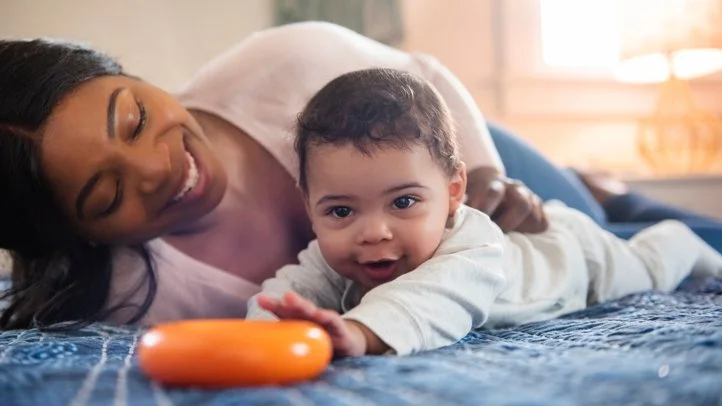How reaching motor milestones helps babies reach social and cognitive milestones too
Written by Dr. Áine Ní Choisdealbha.
Summer is a great time to try out new hobbies, but it takes time to learn the skills involved in crafts like knitting or sports like archery. Even trying to get better at things we already know how to do, like running or cooking, can take time. We have to learn how to coordinate our limbs and work with new tools, we need to build the strength to support these new movements, and we also need to think about what we’re doing before it starts to come to us naturally and easily.
This makes the vast changes in babies’ and toddlers’ skills over the first few years of life seem completely remarkable. At first, babies can’t even hold their heads up. They might have a strong grip, but when a newborn closes his or her hand around your finger, that behaviour is a reflex, meaning they don’t have control over it. Within six months or so, they’re sitting up, preparing to crawl, and starting to pick up small toys and to feed themselves. Within a few years, they can run, jump, dance, and draw. How do they learn all of these skills so quickly, and how does this help their development in general?
Motor Milestones
Motor milestones are new abilities that babies and toddlers develop, using their bodies. Government agencies in many countries, including the HSE in Ireland, often have resources for parents which describe the typical milestones a child will have reached by a certain age. Milestones that every knows about are things like walking, or before that, when a baby learns to stand up by holding onto a piece of furniture or someone’s hand. Parents will know about other milestones, like when a baby starts to sit up without needing to balance on their hands, or when they start to use a “pincer” grip to pick up small objects between the finger and thumb. This milestone usually means that parents have to be vigilant about what small things the baby picks off the floor to try and eat!
Reaching a motor milestone doesn’t just mean that a baby or toddler has learned a new skill. It can support development in other domains too. For example, learning to sit without leaning on their hands or being held up helps social development, because it means that babies can spend more time facing their caregiver during play (Kretch et al., 2023). Learning to walk can help babies and toddlers with their language development (Walle & Campos, 2014). There are a few possible reasons for this. Being able to walk around independently means that babies can use their hands to gesture or point, and their caregivers can respond by naming whatever they are pointing at. Walking also means that babies need to hone their ability to pay attention and focus (Mulder et al., 2022), because taking a few steps or turning around means that what we see can change very quickly!
A different example: Reaching across the body
There are other interesting milestones that scientists care about but which parents might not have thought about before. For example, when babies start reaching for toys and other objects, they usually use the hand on the same side as the toy. They don’t typically reach across their own bodies, something that the developmental psychologist Jerome Bruner (1969) called the “mysterious midline barrier”. At 12 weeks, some infants will reach across their bodies if an object is put in front of them but the nearest hand is tightly swaddled and can’t reach out (Provine & Westerman, 1979). However, they don’t start to spontaneously reach across their bodies until around 4 months of age (Sgandurra et al., 2012). Some infants don’t reach across their bodies until 8 months or later (Morange & Bloch, 1996).
Why would reaching across the body be so important, compared to any kind of reaching? One reason is that it supports the development of other motor skills. Sometimes, it is more efficient to reach across the body because our other hand is occupied, or because we are moving toys from one location to another. One-year-olds who reach across their bodies more often, are also more likely to figure out when someone else is going to reach across their bodies (Melzer, Prinz & Daum, 2012).
Reaching across the body might also be related to handedness. Generally, it’s not possible to tell if a child is left- or right-handed while they’re still a baby, but some babies do show a preference for using their right or left hand (Michel et al., 1985). At 12 months, babies start to reach across the body more, and the most common pattern is for babies to reach to the left side with their right hand (Rönnqvist & Domellöf, 2006).
Even if it’s not related to handedness, learning that you don’t have to just use your left hand for the left side of space, and your right hand for the right side, opens up lots of possibilities. Sometimes we need two hands to do something, for example one to hold a jar steady, and the other to twist the lid off. Reaching across the body is linked to babies performing more two-handed actions (Van Hof, van der Kamp & Savelsbergh, 2002). Reaching across the body is something we, as adults, do all of the time - if you watch your baby next time they’re playing, maybe you’ll see them do the same thing!
Studies at the UCD Babylab
At the UCD Babylab, we are interested in how babies learn new motor skills, and how that helps their development, particularly their social development. Right now, the BIPEDAL study is recruiting babies between 4 and 6 months, 8 and 10 months, and 12 and 14 months for an EEG study. If you’re interested, you can read our information sheet and sign up here.
Learn more about your baby’s motor milestones with this handy guide created by Dr. Ní Choisdealbha.
References
Bruner, J. S. (1969). Eye, hand, and mind. In D. Elkind, & J. H. Flavell (Eds.), Studies in Cognitive Development: Essays in Honour of Jean Piaget. Oxford: Oxford University Press.
Kretch, K. S., Marcinowski, E. C., Hsu, L. Y., Koziol, N. A., Harbourne, R. T., Lobo, M. A., & Dusing, S. C. (2023). Opportunities for learning and social interaction in infant sitting: Effects of sitting support, sitting skill, and gross motor delay. Developmental Science, 26(3), e13318.
Melzer, A., Prinz, W., & Daum, M. M. (2012). Production and perception of contralateral reaching: A close link by 12 months of age. Infant Behavior and Development, 35(3), 570–579. https://doi.org/10.1016/j.infbeh.2012.05.003
Michel, G. F., Ovrut, M. R., & Harkins, D. A. (1985). Hand-use preference for reaching and object manipulation in 6- through 13-month-old infants. Genetic, Social, and General Psychology Monographs, 111, 407–427.
Morange, F., & Bloch, H. (1996). Lateralization of the approach movement and the prehension movement in infants from 4 to 7 months. Early Development and Parenting, 5(2), 81–92.
Mulder, H., Oudgenoeg-Paz, O., Verhagen, J., van der Ham, I. J., & Van der Stigchel, S. (2022). Infant walking experience is related to the development of selective attention. Journal of Experimental Child Psychology, 220, 105425.
Provine, R. R., & Westerman, J. A. (1979). Crossing the midline: Limits of early eye-hand behavior. Child Development, 50(2), 437–441. https://doi.org/10.2307/1129420
Rönnqvist, L., & Domellöf, E. (2006). Quantitative assessment of right and left reaching movements in infants: A longitudinal study from 6 to 36 months. Developmental Psychobiology, 48(6), 444–459. https://doi.org/10.1002/dev.20160
Sgandurra, G., Cecchi, F., Serio, S. M., Del Maestro, M., Laschi, C., Dario, P., & Cioni, G. (2012). Longitudinal study of unimanual actions and grasping forces during infancy. Infant Behavior and Development, 35(2), 205–214. https://doi.org/10.1016/j.infbeh.2012.01.003
Van Hof, P., Van Der Kamp, J., & Savelsbergh, G. j. p. (2002). The relation of unimanual and bimanual reaching to crossing the midline. Child Development, 73(5), 1353–1362. https://doi.org/10.1111/1467-8624.00476
Walle, E. A., & Campos, J. J. (2014). Infant language development is related to the acquisition of walking. Developmental Psychology, 50(2), 336-348.


